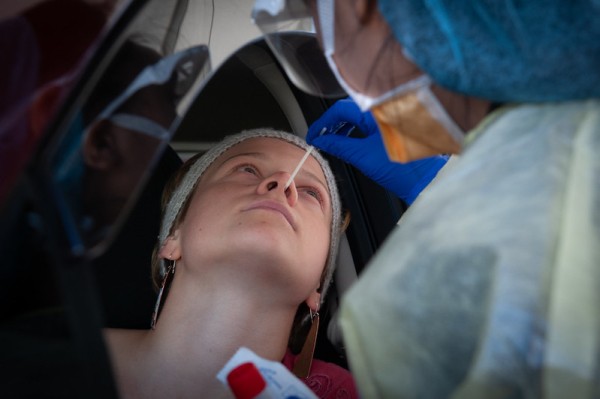Dr Jaijus Pallippadan-Johny1, Dr John McDermott2, Rodney Jones1 and Michael Duddin1 (1 Wigram Capital Advisors, Auckland; 2Motu Economic and Policy Research, Wellington)
In this blog, we introduce our modelling approach to estimating the transmissibility of the SARS-CoV-2 virus, the cause of the COVID-19 pandemic. We demonstrate the usefulness of the Wallinga model for the calculation of the effective reproduction number and show the major impact of the lockdown on containing the pandemic in New Zealand.
The global COVID-19 pandemic represents an unprecedented public health and economic crisis. As the SARS-CoV-2 virus spread across the globe in early 2020, there was a clear need to find a modelling approach that could be used by policymakers and non-specialists to monitor the spread of the virus, and allow timely risk assessments to be made at critical times.
The reproduction number (R0) is an epidemiologic metric used to describe the transmissibility of an infectious disease. Simply, it is the average number of secondary cases generated by a primary case in a fully susceptible population. The actual transmissibility is usually not constant but varies over time in response to such things as an influx of infected travellers into a country, containment measures, as well as voluntary social distancing. Hence, using an effective reproduction number (Re), which represents the number of secondary cases per infectious case at time t, is a better measure.
It is extremely difficult to measure the value of Re during an epidemic because of the lack of information about who infected who and details of individual outbreaks. For this reason, mathematical models can be used to quantify R, which in turn can provide important insights into the significance of the outbreak.
In the aftermath of the SARS pandemic in 2003, Wallinga and Teunis (2004) developed a likelihood-based estimation of R based on generation time distribution (w(τ)) and daily onset cases. There is an open source R software package that allows for estimating R0 using the Wallinga method.
The approach adopted by Wallinga and Teunis allows the calculation of daily Re, which in turn can be used to construct a forecasting model of likely new cases over the next few weeks. This provided an important tool for monitoring the path of the SARS-CoV-2 virus in real time.
Generation time
Estimation of the Re requires two elements: data on the number of new cases per day, and an assumed probability distribution of generation intervals. The generation interval describes the time duration from the onset of infectiousness in a primary case to the onset of infectiousness in a secondary case infected by the primary case. As infection time is generally unobservable, it is common practice to estimate the generation interval via the serial interval, which is the time between symptom onset for an infected person and symptom onset for their infector. To provide a suitable generation interval we need to assume the mean, standard deviation (SD) and its shape. Historical outbreaks of similar diseases can be useful in calibrating these assumptions.
For example, Lipsitch et al estimated a serial interval with a mean of 8.4 days and SD of 3.8 days for the SARS 2003 outbreak. Li et al found a mean of 7.5 days and SD of 3.4 days from the outbreak of COVID-19 in Wuhan (China). Other researchers report a smaller serial interval of about 4 to 5 days (see Ferretti et al and Nishiura et al).
However, it is now widely accepted that a considerable number of COVID-19 patients can be asymptomatic and there is a high probability for the onset of secondary cases longer than 12 days. This tells us that longer generation times from the COVID-19 studies should be considered.
In our model, for estimating the COVID-19 Re, we used a generation time distribution with a peak probability at 5 days and a long tail of 28 days, as indicated in figure 1. While the length of this tail is unusual, it does seem to better represent the behaviour of the SARS-CoV-2 virus, and the persistence of small positive case numbers in places such as South Korea and Hong Kong.
Figure 1: Generation time distribution curves (blue line is for the model developed by the authors for COVID-19)
Comparing SARS and COVID-19
Given the parallels with the SARS outbreak, the case data from Hong Kong in 2003 provided an important baseline for the path of SARS-CoV-2. The Re of SARS in Hong Kong in figure 2 is calculated using the generation time distribution given by Lipsitch et al. The results are compared for the period starting when cumulative cases are greater than 300. It was clear from late January 2020 onwards that the Re of SARS-CoV-2 was significantly higher than with SARS.
Figure 2: The path of the effective reproduction number Re during the 2003 SARS pandemic in Hong Kong is compared with that of the COVID-19 in China. Re (dark line) and confidence interval (light shading).
The use of Re allows an assessment to be made as to the seriousness of any particular outbreak and provides an insight into the number of independent infection chains. This is particularly important when an outbreak can be seeded by travellers from abroad, or by movement between cities and regions within a country.
Forecasting onset cases
The forecast model generates multinomially distributed secondary cases based on the generation time distribution, Re, and the known primary cases in a time series manner. The model generates 10,000 epidemic curves for each Re value ranging from 0.1 to 6 with a resolution of 0.1. The epidemic curve that is best fitted to the actual data is then used to project the daily cases over a short-run horizon. We found this approach effective in forecasting case numbers across a number of outbreaks across a 7 to 10-day horizon.
Figure 3: Forecasting model for the spread of SARS-CoV-2 in New Zealand at differing time points including on 23 March prior to the lockdown at Alert Level 4 on 26 March 2020
Tracking the effective reproduction number: New Zealand’s experience
When it was announced that New Zealand was entering a restrictive lockdown on 24 March, the country had 174 reported cases of COVID-19 but with a Re over the previous week of 3.4, having been above 4.5 in the prior week. This signalled that New Zealand was facing multiple outbreaks and faced the prospect of escalating case numbers over the next few weeks.
Models run around 22 March, prior to the move to Level 4 lockdown, forecasted that total case numbers in New Zealand would approach 4,000 within a few weeks. However, by early April the effects of the border closure on 19 March and the full lockdown on 26 March were starting to be observed in actual case numbers, and there was a marked downshift in the forecast for future cases. The model was very accurate day-to-day as case numbers were accelerating prior to lockdown, whereas it began to over-forecast case numbers as the lockdown progressed. This was evidence that the containment policy was working.
Figure 4: The epidemic curve for COVID-19 cases in New Zealand (Ministry of Health data)
By the time lockdown restrictions were eased on 27 April, the Re had declined to 0.2, with new case numbers declining to zero on some days over subsequent weeks.
Figure 5: Daily path of the effective reproduction number (Re) in New Zealand for COVID-19: Light colouring shows the 95% confidence interval of the estimated Re (dark line).
In summary, the New Zealand experience has illustrated the usefulness of the Wallinga model for the calculation of a real-time Re for the COVID-19 pandemic, particularly when coupled with a forecasting model for case numbers.






